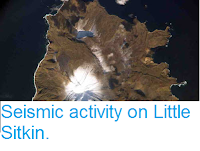The Alaska Volcano Observatory reported am eruption on Mount Cleveland, a 1730 m stratovolcano (cone-shaped volcano made up of layers of ash and lava, located on Chuginadak Island, roughly 500 km southeast of Anchorage in the Aleutian Island Chain, slightly before 6.00 am Alaskan Time (slightly before 3.00 pm GMT) on Friday 2 March 2018. The eruption produced an ash column that rose to an altitude of about 4500 m, and drifted to the northeast.
The location of Mount Cleveland. Google Maps.
The volcanoes of the Alaskan Peninsula and Aleutian Islands are fed by
magma rising from the Pacific Plate, which is being subducted beneath
the North American Plate to the south along the Aleutian Trench. As the
subducting plate sinks into the Earth it is subjected to enormous heat
and pressure, causing more volatile minerals to melt. These then rise
through the overlying North American plate as magma, fuelling the Alaskan
volcanoes.
How the subduction of the Pacific Plate beneath the North American
Plate fuels the volcanoes of Alaska. Alaska Volcano Observatory.
See also...
Follow Sciency Thoughts on Facebook.








